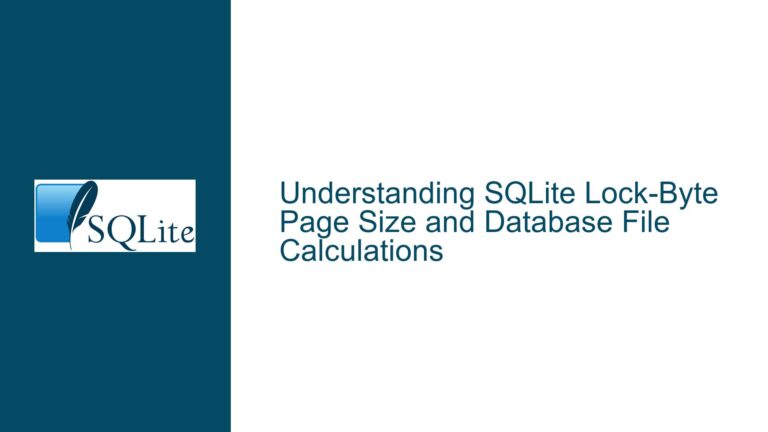Combining STRICT and WITHOUT ROWID in SQLite Table Creation
Issue Overview: Combining STRICT and WITHOUT ROWID in SQLite Table Creation
When working with SQLite, one of the most powerful features is the ability to create tables with specific constraints and optimizations. Two such features are the STRICT mode and the WITHOUT ROWID clause. The STRICT mode enforces strict typing on the columns of a table, ensuring that data types are adhered to rigorously. This is particularly useful in scenarios where data integrity is paramount, and you want to avoid any implicit type conversions that SQLite might otherwise perform. On the other hand, the WITHOUT ROWID clause is used to optimize tables by eliminating the default rowid column, which can lead to significant performance improvements, especially for tables with a primary key that is not an integer.
However, combining these two features in a single table creation statement can lead to syntax errors, as demonstrated in the provided SQLite session. The user attempted to create a table tbltZ with both STRICT and WITHOUT ROWID options but encountered a Parse error near the WITHOUT and STRICT keywords. This issue arises because the SQLite parser expects a specific order and format for these table options, and any deviation from this format results in a syntax error.
The core of the problem lies in the way SQLite processes the CREATE TABLE statement. SQLite allows for a comma-separated list of table options after the final close parenthesis in a CREATE TABLE statement. However, the order and placement of these options are crucial. The STRICT and WITHOUT ROWID options must be specified in a particular sequence, and failing to do so will result in a syntax error. This behavior is documented in the SQLite documentation, but it can be easily overlooked, especially by those who are not intimately familiar with the nuances of SQLite’s syntax rules.
Possible Causes: Misordering of Table Options and Parser Limitations
The primary cause of the syntax error encountered when attempting to create a table with both STRICT and WITHOUT ROWID options is the misordering of these options in the CREATE TABLE statement. SQLite’s parser is designed to accept a comma-separated list of table options after the final close parenthesis in a CREATE TABLE statement. However, the parser expects these options to be in a specific order, and any deviation from this order will result in a syntax error.
In the provided SQLite session, the user attempted to create the table tbltZ with the following statement:
CREATE TABLE tbltZ (name text PRIMARY KEY, salary integer) STRICT WITHOUT ROWID;
This statement results in a Parse error near the WITHOUT keyword. The error occurs because the parser does not recognize the sequence of STRICT followed by WITHOUT ROWID as valid. Similarly, when the user attempted to reverse the order:
CREATE TABLE tbltZ (name text PRIMARY KEY, salary integer) WITHOUT ROWID STRICT;
The parser again encountered a Parse error, this time near the STRICT keyword. This indicates that the parser is sensitive to the order in which these options are specified.
Another possible cause of the issue is the limitation of the SQLite parser itself. While SQLite is a highly flexible and powerful database engine, its parser has certain limitations, particularly when it comes to the ordering and combination of table options. The parser is designed to handle a wide range of SQL syntax, but it may not always accommodate every possible combination of options, especially when those options are relatively new or less commonly used together.
The STRICT mode was introduced in SQLite version 3.37.0, and while it has been widely adopted, it is still a relatively new feature compared to the WITHOUT ROWID clause, which has been available for much longer. As a result, there may be some edge cases or combinations of options that have not been fully tested or optimized in the parser. This could explain why the combination of STRICT and WITHOUT ROWID options is not handled as expected.
Troubleshooting Steps, Solutions & Fixes: Correct Ordering and Syntax for Combining STRICT and WITHOUT ROWID
To resolve the issue of combining STRICT and WITHOUT ROWID options in a CREATE TABLE statement, it is essential to understand the correct syntax and ordering of these options. The SQLite documentation provides clear guidance on how to specify table options, and adhering to this guidance will prevent syntax errors.
The correct syntax for creating a table with both STRICT and WITHOUT ROWID options is as follows:
CREATE TABLE tbltZ (name text PRIMARY KEY, salary integer) WITHOUT ROWID, STRICT;
In this statement, the WITHOUT ROWID option is specified first, followed by the STRICT option, separated by a comma. This ordering is crucial because the SQLite parser expects the WITHOUT ROWID option to come before any other table options. By placing WITHOUT ROWID first, the parser can correctly interpret the statement and create the table with the desired constraints and optimizations.
It is also important to note that the STRICT option should be specified as a separate table option, not as part of the column definitions. The STRICT mode applies to the entire table, not to individual columns, and therefore it must be specified after the column definitions and any other table options.
If you encounter a Parse error when attempting to create a table with both STRICT and WITHOUT ROWID options, the first step is to check the ordering of the options in your CREATE TABLE statement. Ensure that WITHOUT ROWID is specified first, followed by STRICT, and that the options are separated by a comma. If the error persists, verify that you are using a version of SQLite that supports both STRICT mode and the WITHOUT ROWID clause. As mentioned earlier, STRICT mode was introduced in SQLite version 3.37.0, so if you are using an older version of SQLite, you will need to upgrade to a newer version to take advantage of this feature.
In addition to correcting the syntax, it is also important to consider the implications of using both STRICT and WITHOUT ROWID options together. The STRICT mode enforces strict typing on the columns of the table, which can help prevent data integrity issues by ensuring that only values of the correct data type are stored in each column. However, this can also lead to increased rigidity in your schema, as any attempt to insert or update data with an incorrect type will result in an error.
The WITHOUT ROWID clause, on the other hand, optimizes the table by eliminating the default rowid column, which can lead to significant performance improvements, especially for tables with a primary key that is not an integer. However, this optimization comes at the cost of some flexibility, as tables created with WITHOUT ROWID cannot have a rowid column, and certain operations that rely on the rowid may not be available.
When combining these two options, it is important to carefully consider the trade-offs and ensure that the benefits of using both STRICT and WITHOUT ROWID options outweigh the potential drawbacks. In many cases, the combination of these options can lead to a highly optimized and robust table schema, but it is essential to thoroughly test your schema and queries to ensure that they behave as expected.
In conclusion, the key to successfully combining STRICT and WITHOUT ROWID options in a CREATE TABLE statement is to adhere to the correct syntax and ordering of these options. By specifying WITHOUT ROWID first, followed by STRICT, and ensuring that the options are separated by a comma, you can avoid syntax errors and create a table that is both optimized and strictly typed. Additionally, it is important to consider the implications of using these options together and to thoroughly test your schema and queries to ensure that they meet your requirements. With these steps, you can leverage the full power of SQLite’s table options to create efficient and reliable database schemas.






